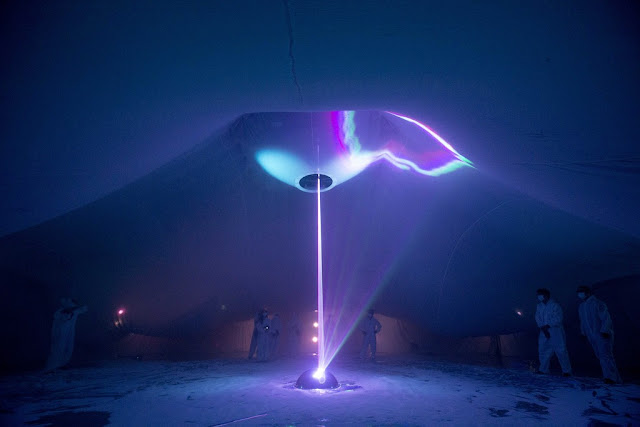- Immersify: St. Stephen’s Cathedral illuminated – Artist Presentation
Artists
ScanLAB Projects (UK), RIEGL Laser Measurement Systems (AT), Dombauhütte St. Stephan zu Wien (AT), Ars Electronica Futurelab (AT)
Abstract
The cathedral church of St. Stephen in Vienna was spatially measured with more than 20 billion laser points. At this unique level of detail, they correspond to a data volume of almost 400 gigabytes and form the basis of the translucent St. Stephen’s Cathedral. This innovative approach offers spectators an interactive journey through the translucent sacred building in stereoscopic 8K.
The novel insights through the layers of the cathedral church were created as part of the European R&D project Immersify, which is dedicated to developing the next generation of immersive media. Over three years, the project partners have created content for highly immersive environments using various techniques and developing tools for processing the produced data.
Source :
https://ars.electronica.art/keplersgardens/en/stephansdom-artist-presentation/
- The City as a House – A speculative exploration of the possibilities of abolishing known forms of habitation
Artists
Rebecca Merlic / VENT Gallery
Abstract
Vast amounts of pictures, sounds, videos and 3D scans are organized as environments in Rebecca Merlic’s The City as a House, in the form of an interactive visual novel. A work about the experiment of a white European 30-year-old heterosexual human living in Tokyo without inhabiting a private apartment over a period of time. A speculative exploration of the possibilities of abolishing known forms of habitation.
Source :
https://ars.electronica.art/keplersgardens/en/the-city-as-a-house/
- Austria makes Sense – Trip to the Austrian Pavilion at the World Expo in Dubai
Abstract
From 1 October 2021 to 31 March 2021, the next World Expo will take place in Dubai under the motto “Connecting Minds, Creating the Future”. Austria is participating with the extraordinary project “Austria makes Sense”. What Austria presents and produces is not only meaningful, but also appeals to all the senses – from the overwhelming nature and unparalleled musical tradition to innovative solutions and state-of-the-art, sustainable construction concepts. An arc of tension – meaningful, sensual, contemplation – which the Austrian Pavilion in Dubai skillfully builds up. With a content concept and an architectural concept that visitors of every nation can experience directly and in an uncomplicated way. Through clever design that leaves a lasting impression. As an integral part of the exhibition, the iLab is dedicated to Austria’s innovative strength. This installation provides information about the Expo and Austria’s participation and is intended to inspire visitors.
Source :
https://ars.electronica.art/keplersgardens/en/expo-2020-dubai/
- Who Am I?
Abstract
Who Am I? is a performative art installation that traces the relationship between a robot and the human body, between programmed and spontaneous, reproducible and irreproducible. The project takes the myth of Pygmalion as a starting point and investigates the relationship between creator/creation and their perception in a world of AI. Who Am I? is based on the interaction between human and robot, by mirroring the relationship between natural and artificial as a deep meditation on human nature.
Project Credits
Concept: Adrian Damian (RO), Director and writer: Alexandru Berceanu (RO); Set designer: Adrian Damian; Motion designer: Andrei Mitișor (RO), Sebastian Comănescu (RO); Soundscape: Vlaicu Golcea (RO); Coreography: Andrea Gavriliu (RO); Costumes: Luiza Enescu (RO), Video designer: Dilmana Yordanova (BG), Răzvan Pascu (RO), Videographers: Ioana Bodale (RO), Adi Bulboacă (RO), Sorin Florea (RO), Performers: Andrea Gavriliu (RO), Mădălina Ciotea (RO), Vlad Bîrzanu (RO), Anda Saltelechi (RO), Meda Victor (RO), Eduard Trifa (RO), Video engineer: Luca Achim (RO), Lighting designer: Cristian Simon (RO), Light engineer: Andrei Delzeg (RO)
Source :
https://ars.electronica.art/keplersgardens/en/who-am-i/
挑選的以上四部2020 ARS的作品有一個共同的特色,就是類似所謂的『沉浸式藝術』。
在表演藝術多方發展的今日,許多觀眾已不再滿足於傳統的單向觀戲模式,而創作者也運用各式媒介創造出不同的戲劇效果與體驗。近年來出現的全新劇場形式 : 沉浸式劇場(immersive theatre),就強調讓觀眾主動體驗、介入表演,跨越劇場的空間限制,打破觀眾觀看與舞台表演之間的固有界線。
假如談到沉浸式電影,通常都是指「虛擬實境電影」,當觀眾戴上VR裝置、似乎完全沉浸在另一個世界,甚至還會有互動與觸覺跟嗅覺的體驗。在強調整個身體與全方位的感官體驗的面向上,像是科技藝術的空間互動沉浸體驗,最有名的如日本team Lab的作品。但虛擬實境是藉由頭套裝置,彷彿於虛擬空間行走,而team Lab作品則是在真實空間行走,但是透過佈滿整個空間的投影和精緻的互動,沉浸到另一個世界中。
現今科技藝術的呈現思維如同沉浸式劇場,不再以表演者、故事、動作、情節為主,這並不表示它們不再重要,而是以觀眾置身在舞台的中心,強調個體觀眾的感知體驗,甚至是獨一無二、不可複製的經驗。「我」的身體感知如何與空間周遭連結,成為展演設計的概念核心。







